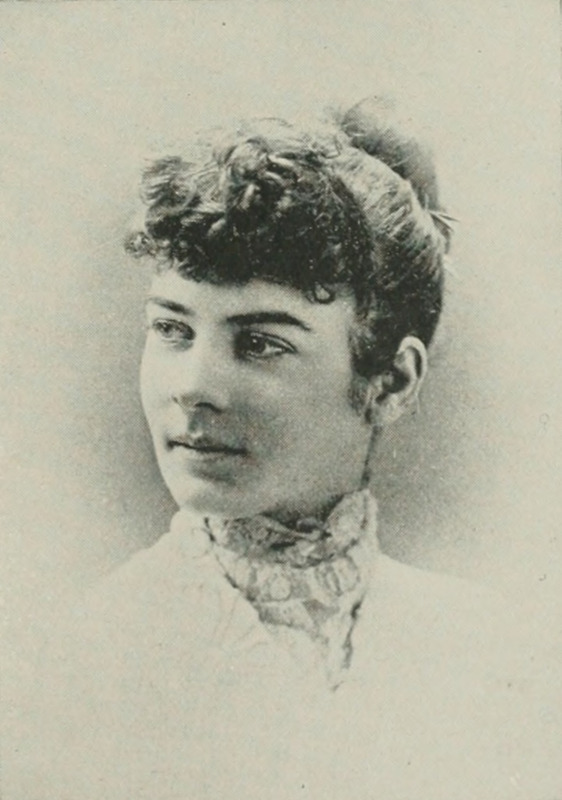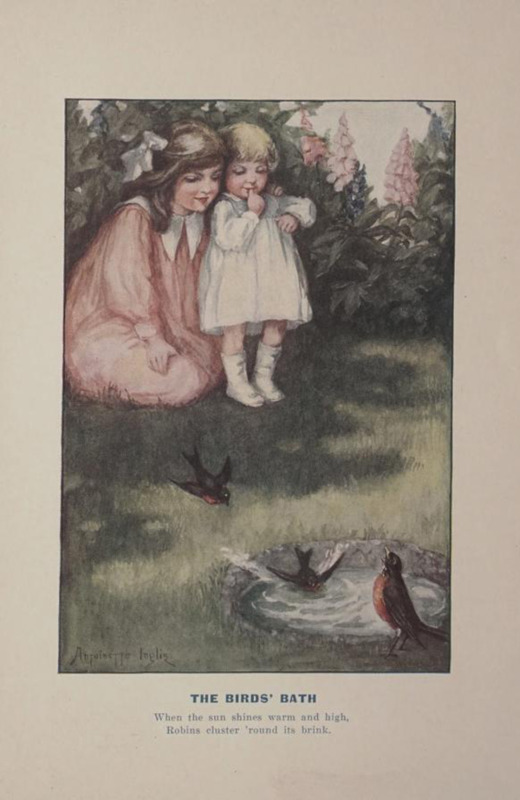2023 marks the centenary of the death of Evaleen Stein. This online exhibit illuminates the literary contributions of an Indiana woman author whose fame, in the words of one commentator, "has not been commensurate with the quality of her output." The exhibit also highlights the work of lesser-known illustrators during the so-called "Golden Age" of children's book illustration.
Curated by Catherine J. Minter.
Evaleen Stein
Life
Evaleen Stein was born into an upper-class family in Lafayette, Indiana, in 1863. Her father John A. Stein (1832-1885) was a respected lawyer and author. Her mother Virginia (1840-1924) became a librarian at Lafayette Public Library after her husband's death and would later hire her daughter for part-time work in the library.
Evaleen trained as an artist and was known for her decorative work, particularly manuscript illumination. She began publishing nature poems in local newspapers in the late 1880s. After the turn of the twentieth century, she specialized in writing fiction for children.
Evaleen was often described as retiring and somewhat ethereal — "a woman of charming qualities and beautiful character. [...] A little apart from the common world because of the absorptions of her artist mind" (Indianapolis Star, December 12, 1923). Rather unfairly, these traits have sometimes been held responsible for limiting her fame and keeping her remote from reality.
Evaleen died in Lafayette on December 11, 1923.
Read more about Evaleen Stein's life.
Literary reputation
Despite her reputation for reclusiveness, Evaleen Stein was a well-known society and literary figure. She was the "center of a large circle of cultured persons" in her Lafayette home (Frances Elizabeth Willard, A Woman of the Century (Buffalo: Moulton, 1893), 683). She was an active member of Midwestern literary groups and associations, and a regular participant in Indiana literary events and benefits.
On May 22, 1907, an event was held at Purdue University "to honor Miss Stein." The announcement of this event in the Indianapolis Morning Star (April 30, 1907) provides a just assessment of Evaleen Stein's literary and artistic reputation during her lifetime:
Miss Stein is both author and artist, and her verse, her juvenile fiction and her decorative painting in the form of old-time illuminations are exquisite, each in its own way. Shy and retiring, she has worked quietly and unassumingly, without effort to seek publicity, but not without the approbation of a constantly widening circle appreciative of the finer things in literature and art.
Four years after her death, Evaleen Stein would feature as one of three women writers in a list of Indiana authors of whom the state "can be proud": James Whitcomb Riley, Lew Wallace, Booth Tarkington, Meredith Nicholson, Charles Major, George Barr McCutcheon, George Ade, Sarah T. Bolton, Gene Stratton-Porter, Evaleen Stein (Indianapolis Star, July 30, 1927). In his article on Stein for Richard Elwell Banta's Indiana Authors and Their Books, 1816-1916 (Crawfordsville, IN: Wabash College, 1949), Purdue librarian William Murray Hepburn would allow that her talents were "of a high order" and that her fame "has not been commensurate with the quality of her output" (p. 303).
Poetry
Evaleen Stein rose to prominence as a poet, publishing her first poems in local newspapers in 1886. As early as 1890, a Midwestern newspaper could describe her as "Lafayette's poetess" (Cincinnati Enquirer, June 8, 1890). Her first volume of poetry, One Way to the Woods, was published by the Boston firm Copeland and Day in 1897; it was followed in 1902 by Among the Trees Again, published by the Bowen-Merrill Company of Indianapolis.
The contemporary reception of Stein's poetry books was mixed. One reviewer would criticize Among the Trees Again as "lacking in vigor of expression and power of personality" (Chicago Daily Tribune, January 10, 1903); another writer would relegate the poems in One Way to the Woods to the category of "modern minor verse" (The Dial, January 16, 1898). Despite such criticisms, commentators generally agreed that Evaleen Stein excelled as an observer of the natural world. In their seminal anthology of Indiana poetry, Benjamin S. Parker and Enos B. Heiney characterize her as already justly popular as a poet owing to her "love and appreciation of nature, her skill in descriptive verse," and as "the peer of the best among the poets of natural scenery and conditions" (Poets and Poetry of Indiana (New York: Silver, Burdett and Company, 1900), 456).
Stein found an effusive admirer in the Indianapolis writer and critic George S. Cottman, who lauded her as a poet who could depict nature without introducing human associations: "The art-expression of Evaleen Stein is exactly analogous to that of the landscape painter whose theory is beauty for beauty's sake" ("A Votary of Nature," Indianapolis Journal, September 6, 1896). According to Cottman, Stein was not merely a gifted observer of nature, but rather "a spirit passionately in love with the green earth and the blue heavens and all the things that dwell therein. [...] An exquisite spirit, sensitive to the finest harmonies, responsive to the softest breaths, and which, not infrequently, goes probing with clear vision deep into the intangible mysteries." Cottman would remain one of Stein's most enthusiastic devotees.
A balanced assessment of Evaleen Stein's achievements as a poet can be found in R. E. Banta's Indiana Authors and Their Books, 1816-1916. Here, William Murray Hepburn pays tribute to Stein's "great descriptive power" and her ability to depict nature in sometimes "scientific" detail, while underscoring her preference for "the softer and less spectacular features of nature and of human life," for "peaceful and joyous manifestations" rather than nature red in tooth and claw (Banta, Indiana Authors, 302). Hepburn also remarks that Stein excelled as a "versifier," confining herself to traditional poetic forms.
Books for children
Children play at being great and wonderful people, at the ambitions they will put away for one reason or another before they grow into ordinary men and women.
(Lady Augusta Gregory, Gods and Fighting Men (London: John Murray, 1904), xv)
Evaleen Stein's first story for children, "The Page of Count Reynaurd," appeared in the popular children's magazine St. Nicholas in 1898/99; it was followed a year later by "Félix." Both stories were subsequently included in her first book for children, Troubadour Tales (1903). This short story collection would be followed by ten short novels published between 1906 and 1924, as well as three further books of children's stories, two of which were published posthumously. This exhibit devotes one site page to each of these fourteen works.
Evaleen Stein's books for children take their inspiration from their author's knowledge of medieval illuminated manuscripts, from her interests in Western European history, literature, and folklore, as well as from her travels in Europe. With just one exception, these books are set in Western Europe, often in the Middle Ages. Their protagonists are brave, spirited children with noble ambitions and high ideals. Stein's contemporaries praised her books for children as lively and faithful depictions of past times and people, and as valuable introductions to history for young readers.
To a modern audience, these books may seem more about children than they are for them, but the "grown-up" quality of Stein's fiction for children was typical at her time of writing, reflecting early twentieth-century ideals of children's literature as educational and edificatory. Upon publication of Our Little Crusader Cousin of Long Ago, a story particularly rich in historical information, a writer in the Indianapolis Star (April 6, 1921) would praise the utility of Evaleen Stein's books for children, contrasting it with the "feebleness" of much children's writing. In the eyes of another contemporary, Stein's works of juvenile fiction were "as carefully written as if intended for older and more critical readers" (Indianapolis Star, November 13, 1911).


